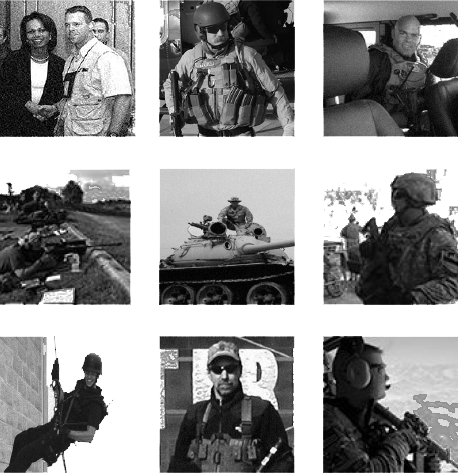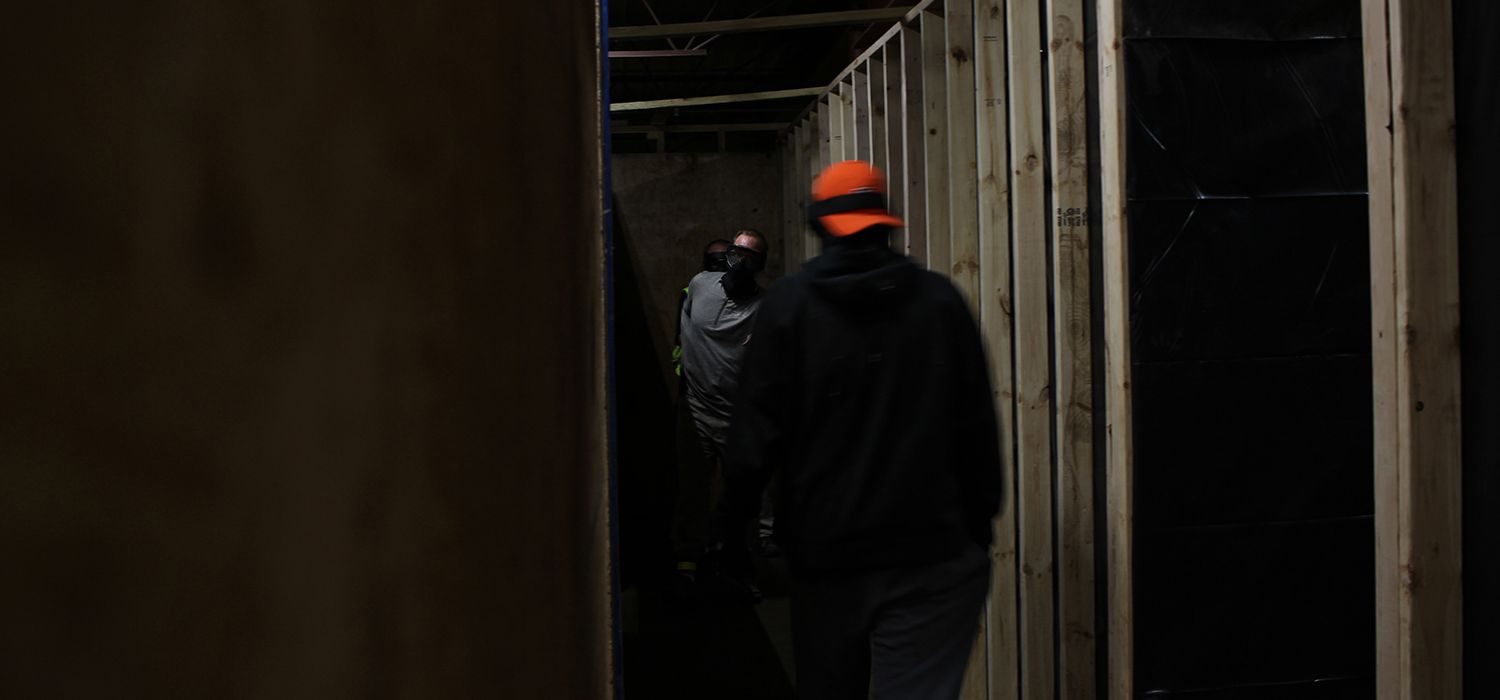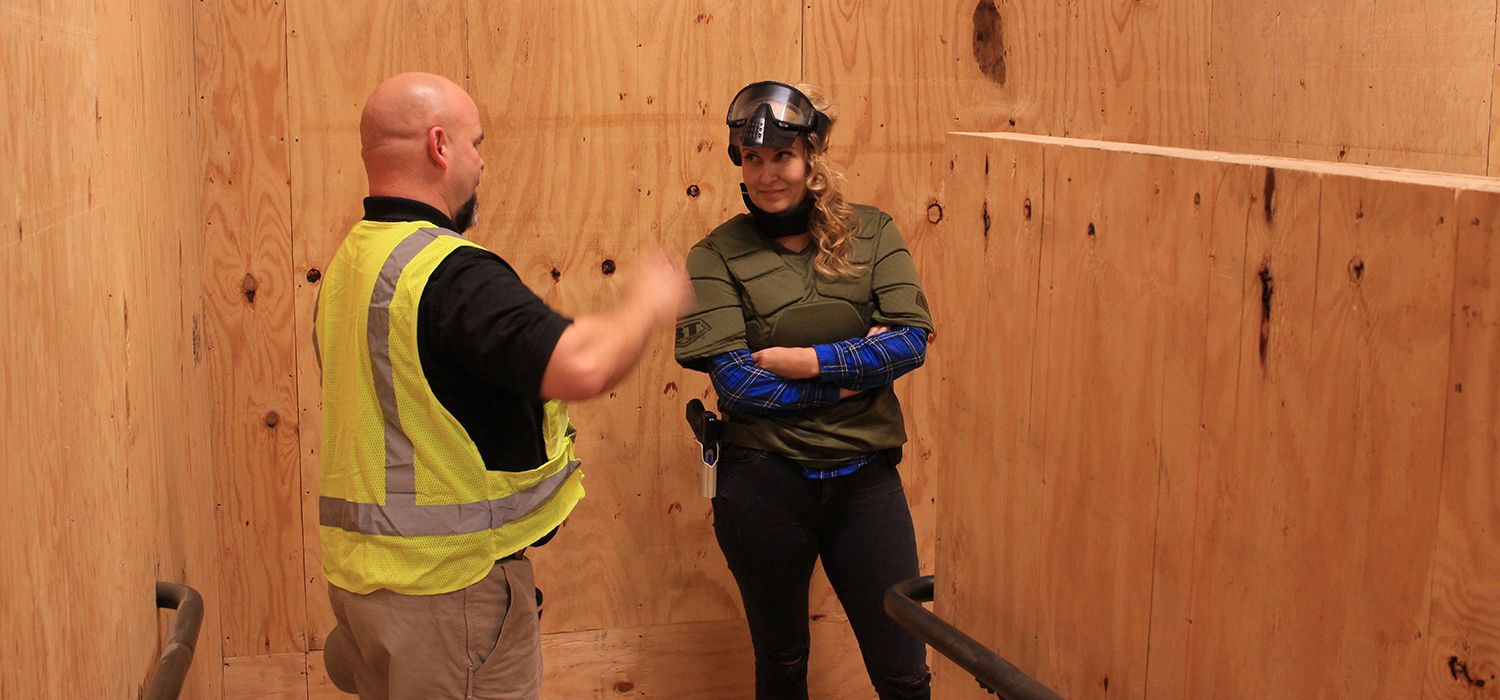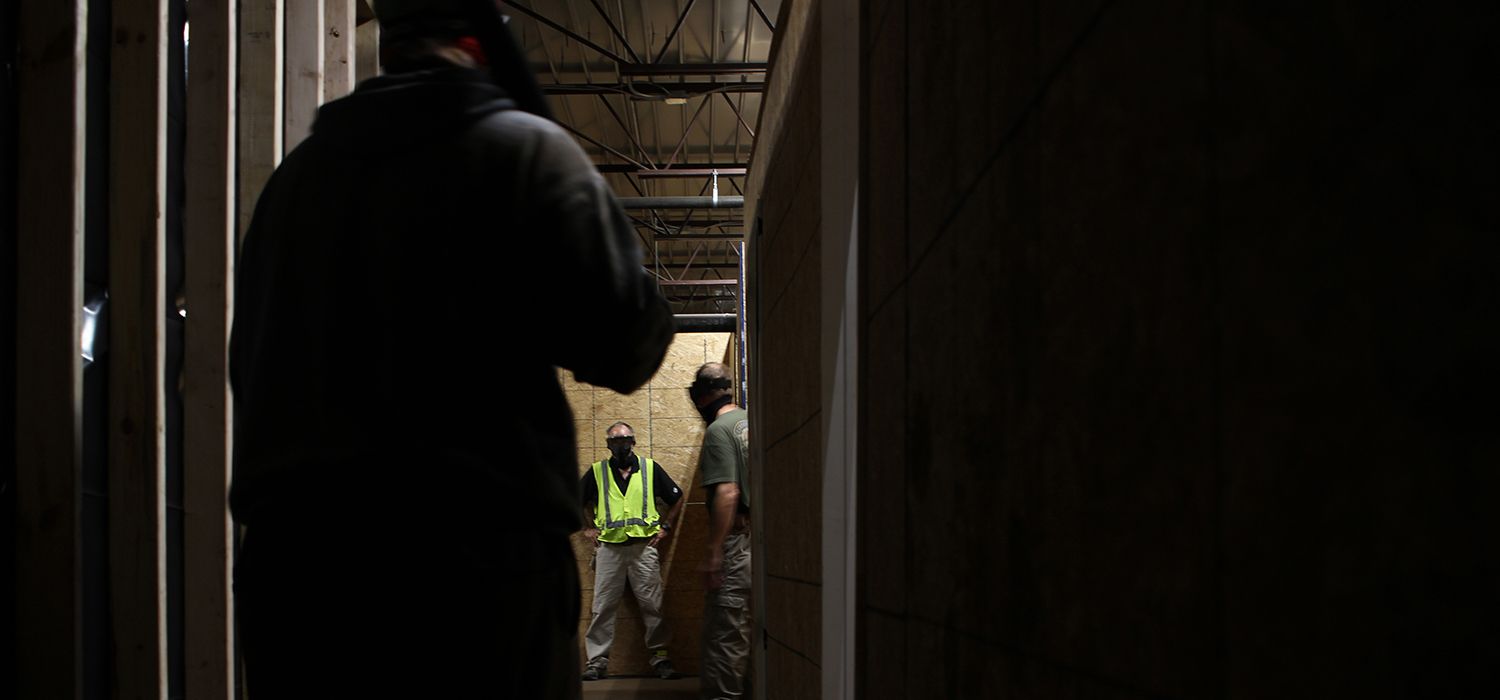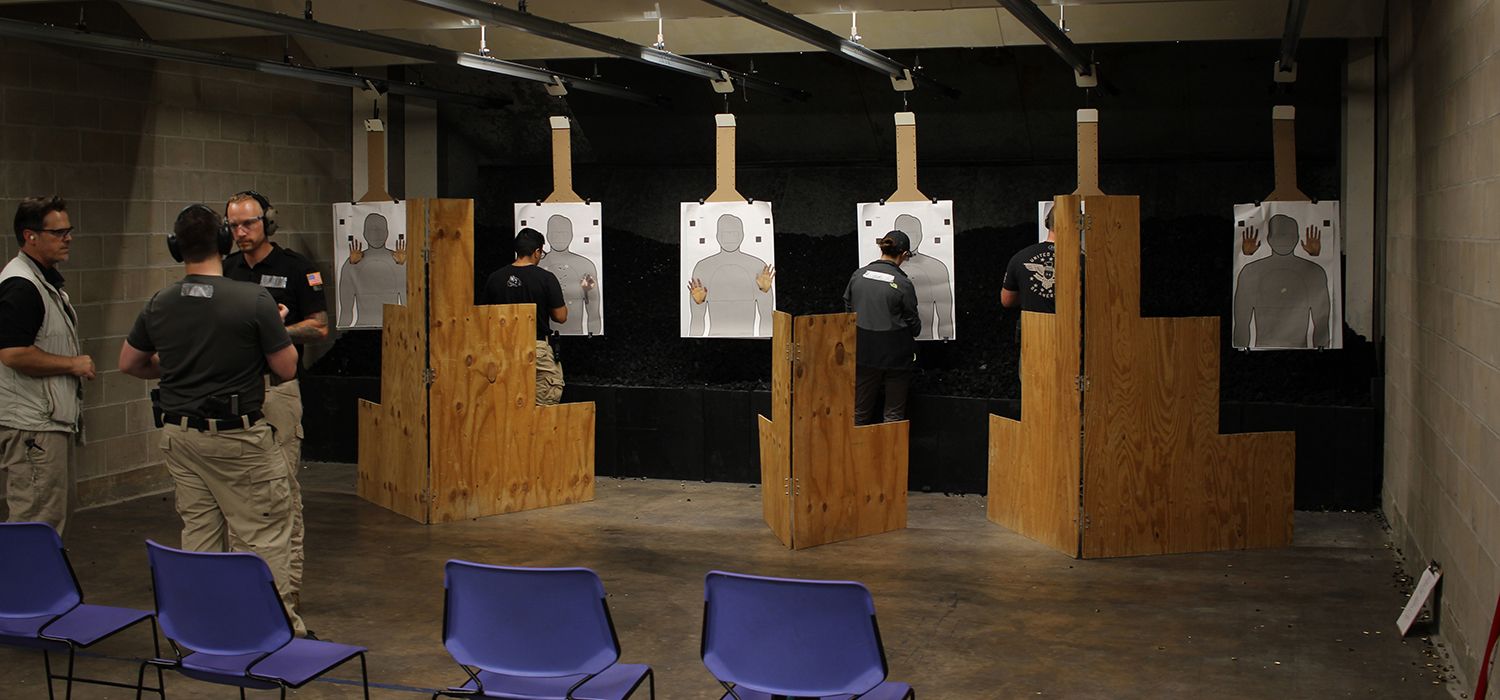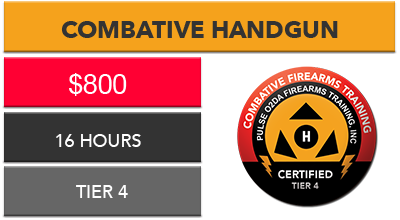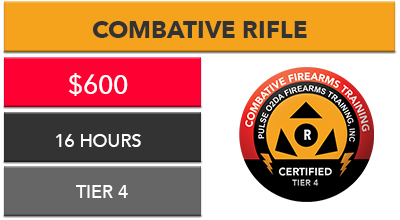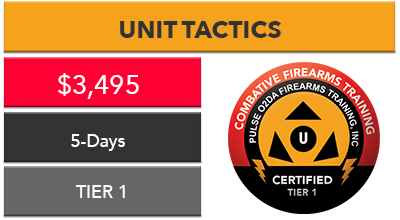DSI TRAINING PHILOSOPHY The Industry Standard Vs. The DSI Standard
Using military, law enforcement, and common private industry training standards as a gauge we want to give you a sense of how the DSI standard compares to the "industry" standard.
The industry standard focuses on range safety and artificiality by using tightly controlled, on-line, square range drills or movement under tightly controlled drills (such as "box" drills), in order to focus on draw speed and hits in a given area under a certain time limit. This type of training is often accompanied by hours in the classroom presenting declarative knowledge, which eats into the available live-fire training time. When critical topics like the use of force are taught in a classroom, rather than on your feet in the sudden, uncertain, violent, and chaotic setting of combat (real or simulated) students are more likely to either overreact or to hesitate and be afraid to apply the appropriate level of force.
DSI begins by looking at reality: the actual conditions of a gunfight. We believe that fundamental firearms skills must be integrated at the earliest possible moment with maneuver (movement with purpose). It is for this reason that our Tier 4 training (such as our Tier 4 Combative Handgun Program) teaches students how to not just maneuver, but by the end of the 16-hours of on-range training, they can safely maneuver in a 360 low/no light environment, properly user cover and keep their weapons functional, apply self-and buddy aid through simple first aid techniques to stop bleeding, and clearly communicate with others and authorities.
We also believe that most of the declarative knowledge (the things we can talk, hypothesize, and argue about) can be absorbed by the student through readings, narrated videos, and specific drills at specific times on his schedule and on his own premises before he ever sets foot on a range - especially if he has access to instructors to answer all of the questions that may arise during their training, and give them personalized advice in regards to a legitimate training plan. We believe that your paid, on-range, supervised training time is a precious resource that should be maximized, not spent discussing things that can be covered online or via a conference call.
Because of this, DSI has developed a uniquely personalized approach to training, that allows you to quickly gain the skills you need to become a competent individual operator, by taking full advantage of technology and engaging your instructor on a regular basis both on the range, and via multiple live Online training opportunities with your DSA.
For instance, DSI doesn't believe in "one and you're done" training events, so students can maintain access to current and updated training and practice guides, training opportunities (on-range and online - through the Defense Academy) while their DSAs will remain available to answer questions and concerns, tie them into their local communities defense network, and offer ongoing training opportunities such as Tune-Up training events to better prepare students for their next level of training.
Furthermore, DSAs make themselves available to answer your questions with their weekly Live Post-Course Q&A, where you can get your questions answered directly. Most importantly, your DSI Certified DSA hosts thrice-weekly 30-minute Online Dry Practice Sessions where they will answer all of your self-training questions, help you sharpen your skills, and achieve your training goals between classes by using your fully customizable Daily Training Plan.
However, to be able to competently defend yourself under the normally debilitating stress of a lethal force encounter, DSI believes you need to be both "stress inoculated" and "killing enabled" (we didn't coin the terms, their industry jargon, and appropriate).
Regardless of your technical skills, if you have not processed the issues surrounding deadly force well before the moment of crisis, if you cannot act by potentially killing another when it is necessary to save yourself or other innocents, then you stand a high probability of failing. Because one can only make proper decisions in lethal force engagements by way of orientation in the context of Colonel John Boyd’s OODA Loop (the decision-making process), and orientation only comes via experience under conditions as close as possible to those that will exist in a real fight for life (high-stress). Orientation relies on experiential knowledge, which cannot be attained only by reading or talking about scenarios - it must be experienced and experienced successfully.
DSI’s training techniques develop sound, reality-based semi-conditioned responses to maintain your situational awareness, maneuver safely, and react aggressively to contact. Your trained gun handling and maneuver skills learned in Tier 4 will take care of themselves if properly rehearsed (and if you are following our recommend Daily Training Plan, they will be), and the higher-level conscious decisions – whether to shoot, how and whom to shoot – are fast, focused, and uncluttered.
Therefore, you will train this way from the start in both Tier 4 dry and live-fire drills, and then reinforce that learning through challenging RBT (Reality Based Training) scenarios in our Tier 3 Individual Tactics training programs.
RBT is a type of simulation or "force-on-force" training that provides stress inoculation - allowing the student to experience what violence looks and feels like during a lethal force confrontation. Because of the immersive nature of the training, the brain and body can absorb and process the experience as if it were actually occurring to nearly the same degree as if it were an actual situation. RBT boosts the student's confidence in his ability to dominate adversaries under the normally debilitating stress of a lethal force encounter. This type of experiential training builds the fund of applicable experience (that vital "Orientation" phase of Boyd's Decision Making Process) that will speed effective decision making and effective performance in a crisis.
Students learn how distance and reaction time force decision making in a lethal force confrontation. They learn how to test for compliance and de-escalate a situation by clear, forceful verbal commands. They learn how to quickly assess and react to a wide variety of threats, and apply their decision making, gun handling, and tactical skills in realistic scenarios, under conditions that include low light, multiple adversaries, stress, limited time, and uncertainty. They learn how to communicate effectively with 9-1-1 operators and responding law enforcement officers.
Solid curricula that pre-loads the declarative knowledge, and then teaches integrated firearms and tactical skills in a reality-based environment will produce individuals and teams more capable than most military and police units in businesses, churches, and schools, such as those available through our Tier 2 Team Tactics program. We base this statement on our personal experience of having trained thousands of military and law-enforcement personnel over 25 years.
Operational police and military units (those units actively "kicking in" doors day in and day out) may be able to outperform our clients in certain aspects, based on that all-important factor of experiential learning (basing actions and decisions under stress on a fund of prior, applicable experience). But DSI can develop and implement effective training faster, applying the best and latest techniques and lessons-learned; and present it in a more compressed, highly effective format because we have neither bureaucratic hoops to jump through, nor institutional inertia to overcome.
While you can and do learn a lot in your pre-course and range training, a key element missing from most training programs is post-course training and support. DSI supports your continued training by giving you access to post-course resources, individualized training advice after your course, and ties you into your community with other like-minded individuals (law enforcement, defense lawyers, etc).
In your post-course training, you will learn how to continually sharpen and refine the skills you learned on the range by using two key resources: The DSI Training Notebook and the tool of dry practice via the Daily Training Plan.
The DSI Training Notebook provides you the mechanism to utilize a proven method of embodying Boyds Decision Making Process (Observation, Orientation, Decision, and ACTION or the “OODA Loop”) into achieving your training goals (whatever they may be) quickly, through a proven dry practice system that you can use daily to sharpen those skills you are learning on the range. The Training Notebook is John Boyd’s ‘White Box’ in that it allows you to directly interface with and use Boyd’s Decision Making Process in guiding your own path forward using proven curricula and performance-enhancing training system on a continual basis.
Furthermore, this Training Notebook will not only form the basis of your personal training plan and become one of the most important training tools in your "tactical toolbox", but it will also form the basis of your team's training plan as well.
While achieving your goals is of primary importance, there is a second very important role this Training Notebook plays as well.
By using it, it will provide you with a system of documenting your efforts and training in case you ever need to defend yourself in court after you have defended yourself or others.
Tying all of this together are some of the finest, amiable, and well-trained firearms and tactics instructors on the planet - DSI certified Distributed Security Advisors, who have a vested interest in helping you achieve your personal training goals and ensuring you have the skills, knowledge, abilities, and the confidence you need in order to win the fight of your life. Your DSI CFI will answer all of your questions before you ever step on the range, they will ensure you have a safe, productive, challenging, and enjoyable range training experience, and they will guide you through each step in your post-course training with sound advice and guidance so you can continue to sharpen your skills after your training course.
